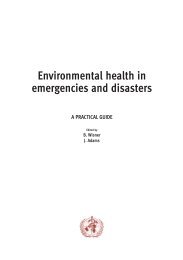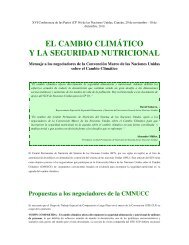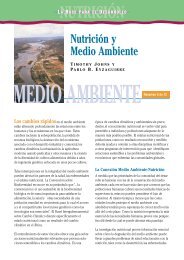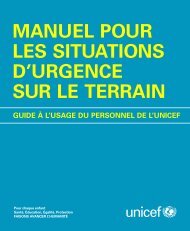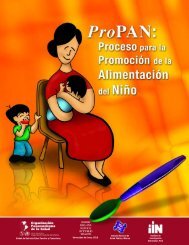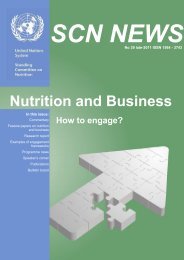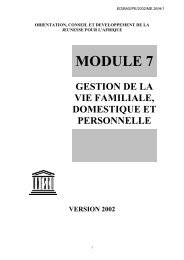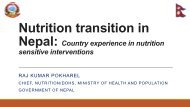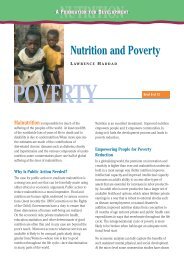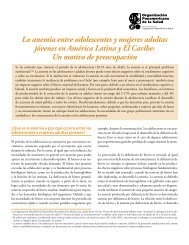SCN News No 36 - UNSCN
SCN News No 36 - UNSCN
SCN News No 36 - UNSCN
You also want an ePaper? Increase the reach of your titles
YUMPU automatically turns print PDFs into web optimized ePapers that Google loves.
www.unsystem.org/scn FEATURES 17<br />
Nutrition interventions that can accelerate the reduction of maternal and child undernutrition<br />
Robert Black, Johns Hopkins University, lead author from the Lancet Nutrition Series<br />
Introduction<br />
The Maternal and Child Undernutrition Study Group, comprised of leading academics and nutrition experts<br />
from the UK, USA, Asia, and Africa, has been working over the last two years on a series of five papers on<br />
maternal and child undernutrition in developing countries, the Lancet Nutrition Series (Maternal and Child<br />
Undernutrition Study Group 2008). The Series follows a number of earlier important Series from The Lancet,<br />
such as those on child survival and neonatal health, maternal health and child development, which have<br />
shaped policy and action and show the journal’s commitment to global health. The special series on child<br />
survival, for example, brought additional attention to the issues of child survival (The Bellagio Study Group on<br />
Child Survival 2003). While the Lancet Child Survival Series of course paid some attention to nutrition issues<br />
and interventions, such as the importance of promoting breastfeeding and complementary feeding and to<br />
some of the micronutrients, I think those of us who were involved in that series felt that we had not done full<br />
justice to the issues of nutrition and therefore proposed to do more. As we still felt that there was a big gap<br />
with regard to nutrition, we volunteered to the journal to take on this task, with the five papers of the Lancet<br />
Nutrition Series being the combination of that work (Maternal and Child Undernutrition Study Group 2008).<br />
The Series examines evidence-based interventions that, if implemented at scale, could significantly reduce<br />
the effects of maternal and child undernutrition.<br />
The first two papers quantify the prevalence of maternal and child undernutrition and consider the short-term<br />
consequences in terms of deaths and disease burden, as measured by Disability-Adjusted Life Years<br />
(DALYs), and long-term educational and economic effects and associations with adult chronic diseases<br />
bringing in an array of new and important analysis (Black et al 2008; Victoria et al 2008). The third paper<br />
estimates the potential benefits of implementing health and nutrition interventions that current evidence<br />
indicates are effective and applicable in low- and middle-income countries (Bhutta et al 2008). The last two<br />
papers consider the current state of such interventions and how they could be implemented at scale through<br />
actions at national and global levels, what commitments are required at the country level to respond to the<br />
existing challenges and what action is needed from the international nutrition system (Bryce et al 2008;<br />
Morris et al 2008). As Ms Veneman said in her opening speech, the international nutrition system needs to<br />
see more work, coordination and certainly funding, which is justified for the problem of undernutrition<br />
(Veneman 2008).<br />
This paper mainly focuses on the nutrition-related interventions described in paper 3. It also describes some<br />
of the background for these analyses which concern the basis for describing the problem of maternal and<br />
child undernutrition as described in paper 1 and by Mercedes de Onis in this <strong>SCN</strong> <strong>News</strong> (de Onis 2008).<br />
Background for the intervention modelling<br />
Undernutrition begins with the mother. In the series, we talk about maternal undernutrition for the mother's<br />
health as well as for foetal development and the application in early childhood. This includes not only the<br />
body size issues in terms of low BMI, but also less visible micronutrient deficiencies that can lead to serious<br />
health problems for the mother and intra-uterine growth restriction (IUGR).<br />
We do in the series look at stunting, wasting, underweight and the related disease burden. While previous work<br />
that we and others have done regarding the nutrition-related burden of disease and intervention effectiveness used<br />
underweight, we decided, as described by de Onis in this issue of <strong>SCN</strong> <strong>News</strong>, that it would be much better to look<br />
at stunting and wasting separately, because they do have different programmatic implications. While both stunting<br />
and wasting begin in early childhood, stunting reflects a chronic restriction of linear growth, as indicated by low<br />
height for age, whereas wasting reflects acute weight loss as indicated by a low weight for height. Both conditions<br />
are usually caused by diets that do not provide sufficient nutrients and by high rates of infectious disease.<br />
As described by de Onis, 90% of the 178 million children under five who are stunted in the world live in just<br />
<strong>36</strong> countries. These <strong>36</strong> countries were used in the intervention modelling that we did in paper 3 with actual<br />
back to contents <strong>SCN</strong> NEWS # <strong>36</strong>




